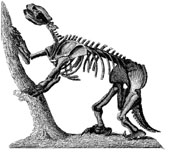
The Burden of History & the Promise of Divine Life
VITAL WORKS RECONSIDERED, #57
A Canticle for Leibowitz. By Walter M. Miller Jr.
Thirty-some years ago, I was in a dark, musty used-book store in downtown Milwaukee when a man appeared around the end of the aisle, handed me a book, and said, “Here, you really ought to read this.” I suppose if I were to add that he then mysteriously disappeared — which he did — you would think I’m making it up. But no, that is how I discovered A Canticle for Leibowitz.
As with most readers of Canticle, what intrigued me were the various parts of the novel: the lovable Brother Francis and his sad end; the Poet and his eyeball; the mystery of Benjamin, a Jewish wanderer; the introduction of the lightbulb to the monastic library; the two-headed Mrs. Grales; the monks picketing the euthanasia station; and extraplanetary colonization. But as fascinating as the parts are, I wasn’t looking at the whole. After reviewing the literary journals, I discovered that the novel’s few existent studies likewise did not look at the whole. Accordingly, I put Canticle in my teaching curriculum, forcing myself to grapple with the thing. At this remove, it seems to me that Walter M. Miller Jr.’s novel attempts to study nothing less than the whole problem of history.
A Canticle for Leibowitz, published in 1959, centers on the abbey of the Albertian Order of Leibowitz in the southwestern desert of the United States. The purpose of the order — as established by its founder, former electrical engineer Isaac Leibowitz — is to preserve the knowledge of a civilization destroyed by the Flame Deluge, or nuclear holocaust. The order’s monks rescue, copy, and memorize ancient knowledge, which, by and large, they don’t understand, as they wait for a new era of peace and reason. While they wait, though, history has its own ideas. Clans develop into kingdoms, which develop into empires; war is waged; and, eventually, nuclear capacity is again achieved and then exploited in a second Flame Deluge. The surviving monks shake the dust of the Earth from their sandals, enter their starship, and depart in order to preserve human civilization, and the Church, in the Centaurus Colony.
Such a barebones summary camouflages a work of enormous complexity.
First of all, the novel’s structure, like time, is cyclical. It opens in the ashes of the first nuclear cataclysm and closes in the rubble of a second. Similarly, it covers a significant chronological stretch, more than a thousand years, from A.D. 2600 to 3800, more or less. Metaphorically speaking, though sometimes literally, the reader looks out at the passage of time from the walls of the monastery, and from the eyes of its abbots. The monastery, then, functions as a still point from which to measure time’s movements.
You May Also Enjoy
The Cypresses Believe in God. By Jose Maria Gironella.
The Spanish Civil War, perhaps more…
Kierkegaard’s concept of “the Apostle” influenced Percy’s presentation of character and theological insight in his fiction.
Americans do read — street signs, job applications, directions for installing video games, glossy magazines. But, sad to say, most Americans do not read literature.

